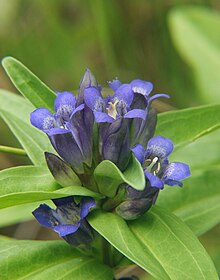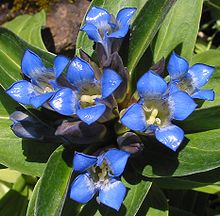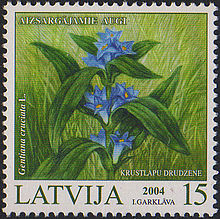Cross gentian
| Cross gentian | ||||||||||||
|---|---|---|---|---|---|---|---|---|---|---|---|---|

Cross gentian ( gentiana cruciata ) |
||||||||||||
| Systematics | ||||||||||||
|
||||||||||||
| Scientific name | ||||||||||||
| Gentiana cruciata | ||||||||||||
| L. |
The cross gentian ( Gentiana cruciata ), also called cruciform gentian , is a species of plant in the genus of gentians ( Gentiana ).
description
Vegetative characteristics
The cross gentian grows as a perennial herbaceous plant and reaches heights of 10 to 40 centimeters.
The leaves are arranged in a basal rosette and distributed crosswise on the stem . The simple, somewhat leathery leaf blades are 5 to 10, rarely up to 15, centimeters in length and 1 to 2.5, rarely up to 3.5 centimeters, mostly egg-lanceolate and usually three, rarely five-nerved. The lower pairs of stem leaves are fused at the base to form a sheath that is usually 1.5 to 2.5, rarely up to 4 centimeters long.
Generative characteristics
The flowering period extends from June to September. The hermaphrodite flower is four-fold with a double flower envelope and 2 to 2.5 centimeters long. The four inner light blue sepals are closely tubular-bell-shaped fused with four mostly broad-triangular and finely pointed calyx teeth; the calyx teeth are much shorter than the calyx tube. The four petals are dirty blue to slightly greenish on the outside, pure blue and unspotted on the inside.
The number of chromosomes is 2n = 52.
ecology
The cross gentian is a mesomorphic, scleromorphic, hibernating green hemicryptophyte .
The pollination is done by insects .
The blue gentian ant ( Phengaris rebeli ) only lays its eggs on the gentian.
With the fallow management near Tauberbischofsheim , a nature reserve with a population of around 900 sticks of the cross gentian was created by ordinance of the regional council of Stuttgart on December 17, 2014, in which the even rarer cross gentian blue ant will find ideal and henceforth secure living conditions.
Occurrence and endangerment
The distribution area of the cross gentian includes Europe (with the exception of Portugal, Great Britain and Scandinavia) and western Asia .
In Austria it occurs scattered in all federal states. In Germany it occurs scattered in the central Neckar basin , in the Swabian Alb, Franconian Alb, Franconian Switzerland, in central Thuringia , in Main Franconia , very scattered in the Alps, in the foothills of the Alps, in Lower Bavaria , rarely in the Weserbergland , in the northern low mountain range, northeast Brandenburg (in the Northeast, center and west strongly declining).
As locations for the limestone cross gentian, light forests, forest fringes, pasture lawns and dry meadows are given. In Central Europe it thrives in montane (to subalpine) altitudes . In the Allgäu Alps, it rises in the Tyrolean part on the Gehrenalpe against the Gehrenspitze up to an altitude of 1700 meters. The cross gentian is a characteristic of the plant society class Festuco-Brometea in Central Europe , but also occurs in societies of the Geranion sanguinei association.
The cross gentian is endangered in Austria in the Pannonian region , as well as in the northern and southeastern Alpine foothills. In 1996 it was rated 3+ = endangered in the Red List of Endangered Plant Species in Germany.
Systematics
The first publication of Gentiana cruciata was in 1753 by Carl von Linné in Species Plantarum , p. 231. The specific epithet cruciata means crossed and refers to the four-fold flower, the corolla of which stand together in a cross shape.
There are two subspecies:
- Gentiana cruciata L. subsp. cruciata
- Carpathian cross gentian ( Gentiana cruciata subsp. Phlogifolia (Schott & Kotschy) Tutin ): This endemic thrives only in the southern and eastern Carpathians . It differs from the nominate form in that it has smaller flowers that are light blue on the outside and white on the inside.
Symbolism and legends
In the Middle Ages , this species was particularly popular and became a symbol of salvation through Jesus Christ , since the pairs of leaves, the corolla, stem and root pulp are cross-shaped, and the common names refer to this .
A Hungarian legend has to do with this type of plant. In the army of King St. László was plague broke out. In the dream an angel appeared to the king who ordered him to shoot an arrow in the air. The herb on which the arrow would fall would heal the sick soldiers. The next morning the arrow fell on the cross gentian and this is how the Hungarian name for this plant species arose: Szent-Lászlo-Kiraly-füre (herb of St. Ladislaus, the king).
swell
literature
- Xaver Finkenzeller, Jürke Grau: Alpine flowers. Recognize and determine (= Steinbach's natural guide ). Mosaik, Munich 2002, ISBN 3-576-11482-3 .
- Wolfgang Adler, Karl Oswald, Raimund Fischer: Excursion flora of Austria . Ed .: Manfred A. Fischer. Eugen Ulmer, Stuttgart / Vienna 1994, ISBN 3-8001-3461-6 .
- Gustav Hegi: Illustrated flora of Central Europe. Pteridophyta, Spermatophyta . 2nd Edition. Volume V. Part 3: Angiospermae: Dicotyledones 3 (3) (Pirolaceae - Verbenaceae) . Carl Hanser and Paul Parey, Munich and Berlin / Hamburg 1966, ISBN 3-489-76020-4 , pp. 2251 (unchanged reprint of the 1st edition from 1927 with addendum).
- Thomas Gaskell Tutin : Gentiana. In: TG Tutin, VH Heywood, NA Burges, DM Moore, DH Valentine, SM Walters, DA Webb (eds.): Flora Europaea . Volume 3: Diapensiaceae to Myoporaceae . Cambridge University Press, Cambridge 1972, ISBN 0-521-08489-X , pp. 61 (English, limited preview in Google Book Search).
Individual evidence
- ↑ a b c Gentiana cruciata L., Cross Gentian. In: FloraWeb.de.
- ^ Gustav Hegi: Illustrated flora of Central Europe. Pteridophyta, Spermatophyta . 2nd Edition. Volume V. Part 3: Angiospermae: Dicotyledones 3 (3) (Pirolaceae - Verbenaceae) . Carl Hanser and Paul Parey, Munich and Berlin / Hamburg 1966, ISBN 3-489-76020-4 , pp. 2251c (unchanged reprint of the 1st edition from 1927 with addendum).
- ↑ Fränkische Nachrichten : “Brachenleite”: Declaration as a nature reserve decided / District President Schmalzl: Supraregional importance for the former military training area / 64.4 hectares are placed under protection . January 22, 2015. Online at www.fnweb.de. Retrieved May 13, 2016.
- ↑ Main-Post : TAUBERBISCHOFSHEIM: The former training site is a nature reserve . February 18, 2015. Online at www.mainpost.de. Retrieved May 13, 2016.
- ↑ a b Michael Hassler, Bernd Schmitt: data sheet from Flora von Deutschland - a picture database , version 3.40.
- ↑ Erhard Dörr, Wolfgang Lippert : Flora of the Allgäu and its surroundings. Volume 2, IHW, Eching 2004, ISBN 3-930167-61-1 , p. 336.
- ^ Erich Oberdorfer : Plant-sociological excursion flora for Germany and neighboring areas . With the collaboration of Angelika Schwabe and Theo Müller. 8th, heavily revised and expanded edition. Eugen Ulmer, Stuttgart (Hohenheim) 2001, ISBN 3-8001-3131-5 , pp. 756 .
- ↑ Helmut Genaust: Etymological dictionary of botanical plant names . 3. Edition. Springer, 2013, ISBN 978-3-0348-9282-7 , pp. 186 ( Cruciata on p. 186 in the Google book search).
- ↑ Karol Marhold: Gentianaceae. : Gentiana clusii. In: Euro + Med Plantbase - the information resource for Euro-Mediterranean plant diversity. Berlin 2011.
- ^ AVH Heyward (Ed.): Flora Europaea notulae systematicae ad floram Europaeam spectantes. In: Botanical J. Linnean Society , Volume 64, 1971, p. 378.
Web links
- Gentiana cruciata subsp. cruciata L., cross gentian (subspecies). In: FloraWeb.de.
- Cross gentian . In: BiolFlor, the database of biological-ecological characteristics of the flora of Germany.
- Gentiana cruciata L. In: Info Flora , the national data and information center for Swiss flora . Retrieved January 23, 2016.
- Thomas Meyer: Data sheet with identification key and photos at Flora-de: Flora von Deutschland (old name of the website: Flowers in Swabia ).
- Gentiana cruciata Online at Botanik im Bild - Flora von Österreich .
- Günther Blaich: data sheet with photos.




